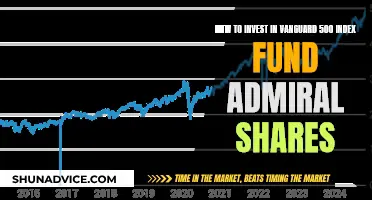
Investing in mutual funds is a popular choice for those seeking a relatively hands-off way to invest in multiple assets at once. A mutual fund is a collection of investors' money that fund managers use to invest in stocks, bonds, and other securities. They are a practical, cost-efficient way to build a diversified portfolio, and with more than 9,000 mutual funds holding over $16 trillion in assets, they are among the most popular investing tools for both individual and professional investors.
When deciding whether to invest in mutual funds, it is important to consider the different types of funds available, the associated fees, and how they fit into your broader investment strategy and goals.
| Characteristics | Values |
|---|---|
| Number of mutual funds | Over 9,000 |
| Total assets held by mutual funds | Over $16 trillion |
| Trade frequency | Once per day |
| Investment types | Equities, bonds, real estate, commodities |
| Investment style | Actively managed or index funds |
| Investment research | Expert analyst opinions, fund-level data, fund ratings, historical and current performance, risk |
| Investment minimums | $100-$3,000 |
| Fees | Sales loads, expense ratios, management fees, sales charges |
What You'll Learn

Mutual funds vs. individual stocks
Mutual funds and individual stocks are both popular types of investments, but they have different traits that cater to investors with different goals. Here is a detailed comparison of the two investment options:
Mutual Funds
Mutual funds are investment vehicles that pool money from multiple investors to buy a diversified portfolio of stocks, bonds, and other assets. They are managed by professionals and offer instant diversification, which reduces risk. Mutual funds are ideal for investors who want to participate in the stock market but don't want to pick and follow specific stocks. Here are some pros and cons of mutual funds:
Pros
- Instant Diversification: Mutual funds invest in a wide range of assets, providing instant diversification and reducing risk.
- Low Cost: Many mutual funds, especially passively managed index funds, have low expense ratios, and some brokerages offer their funds without trading fees.
- Less Time-Consuming: Mutual funds save investors the time and effort of researching and monitoring individual stocks.
- Lower Volatility: Investing in a diversified portfolio of stocks through a mutual fund is likely to be less volatile than investing in a handful of individual stocks.
Cons
- Sales Loads: Some mutual funds charge a fee when investors buy or sell shares, and there may be a fee for early redemption.
- High Costs: Some mutual funds charge a high expense ratio, which can be above 1% of the investor's investment in the fund annually.
- Tax Inefficiency: Mutual funds may distribute gains from the sale of assets, creating a taxable gain for investors even if they haven't sold their shares.
- Underperformance: Actively managed mutual funds may underperform the market, and the expense ratios for these funds are typically higher.
Individual Stocks
Individual stocks represent shares of ownership in a specific company. When a company performs well, its stock price usually increases, providing an opportunity for investors to sell shares at a profit. Here are some pros and cons of investing in individual stocks:
Pros
- Potential for Large Gains: Individual stocks offer the potential for significant gains if the company performs well.
- Easy to Trade: Individual stocks are easy to trade through online brokers, and many brokerages don't charge trading fees.
- Control: Investors have control over which stocks they invest in.
Cons
- Potential for Large Losses: If a stock's price drops and doesn't recover, investors can incur substantial losses.
- Time-Consuming Research: Researching and choosing the right stocks for a portfolio can be time-consuming.
- Stress: Investing in individual stocks can be an emotional rollercoaster and may not suit investors with a low-risk tolerance.
- Brokerage Fees: Buying or selling individual stocks may incur brokerage fees.
The choice between mutual funds and individual stocks depends on an investor's goals, time horizon, and risk tolerance. Mutual funds offer diversification and reduced risk, making them suitable for long-term retirement portfolios. On the other hand, individual stocks provide the potential for higher returns but come with more volatility. For beginners, starting with index mutual funds and gradually branching out into individual stocks after gaining experience can be a prudent strategy.
Corporate Bond Funds: When to Invest for Maximum Returns
You may want to see also

Actively managed funds vs. passive funds
Mutual funds are a popular investment tool for those seeking to beat the market or simply gain access to a wide range of investments without having to purchase individual stocks or bonds. There are two main types of mutual funds: actively managed funds and passive funds. So, what's the difference, and which is better? Let's take a closer look at the pros and cons of each.
Actively Managed Funds
Actively managed funds are just as the name suggests – actively managed by a portfolio or fund manager. These professionals aim to beat the market by hand-picking and choosing investments based on in-depth analysis. They have the flexibility to buy "diamond in the rough" stocks and can use various hedging techniques, such as short sales or put options. Actively managed funds also allow for more tailored tax management strategies for individual investors.
However, active management comes at a cost. Actively managed funds tend to have higher expense ratios compared to passive funds due to the frequent buying and selling of investments. This active trading can also result in more taxable capital gains for fund shareholders. Additionally, active management introduces the risk of human error, as even the most skilled fund managers can make costly mistakes.
Passive Funds
Passive funds, on the other hand, are passively managed and aim to mirror the performance of a specific market index, such as the S&P 500. Passive investing involves buying and holding investments with minimal portfolio turnover. Instead of trying to beat the market, passive funds try to match the market's performance as closely as possible. This strategy is often referred to as a "buy-and-hold" mentality.
One of the biggest advantages of passive funds is their low cost. Since there is no active management involved, passive funds have ultra-low fees. They are also highly transparent, as it is always clear which assets are in an index fund. Additionally, passive funds are tax-efficient due to their buy-and-hold strategy, which typically does not result in massive capital gains taxes.
However, passive funds have their limitations. They are restricted to a specific index or set of investments, providing little flexibility to deviate from the market's performance. As a result, passive funds rarely beat the market and often have smaller returns compared to actively managed funds. Passive investors also rely on fund managers to make decisions, which means they may not have a say in their specific investments.
So, Which is Better?
The choice between actively managed funds and passive funds ultimately depends on your individual circumstances, risk tolerance, and investment objectives. If you are willing to take on more risk for the potential of higher returns, actively managed funds may be more suitable. On the other hand, if you prefer a more hands-off approach and are content with market-level returns, passive funds could be the better option.
It's worth noting that combining both strategies in a well-diversified portfolio can help minimize the wild swings in stock prices during volatile periods. Many investment advisors advocate for a blend of active and passive investing to take advantage of the strengths of both approaches.
Value Index Funds: Smart, Long-Term Investment Strategy
You may want to see also

Mutual funds for retirement accounts
Mutual funds are a popular investment tool for those seeking to beat the market or simply access a wide range of investments without having to purchase stocks or bonds individually. They are also a common feature of defined contribution retirement plans, such as a 401(k) or an individual retirement account (IRA).
There are several types of mutual funds that are well-suited to retirement accounts, including:
- Target-date funds: These funds are designed for people saving for retirement and shift from riskier stock investments to more conservative fixed-income investments as the investor gets closer to retirement. The year in the fund's name refers to the target retirement year of the investor. For example, the Vanguard Target Retirement 2035 fund is designed for people who plan to retire around 2035.
- Index funds: These funds aim to track the performance of a specific market index, such as the S&P 500. They are often more diversified and lower risk than individual stocks and typically have lower fees than actively managed funds.
- Balanced funds: These funds own a mix of stocks and bonds, aiming to balance growth with the stability and income generation of fixed-income assets. The Vanguard Wellington Fund, for example, allocates about 65% of its portfolio to stocks and the rest to bonds.
- Retirement income funds: These funds are designed for retirees and focus on generating stable cash flow and decent capital appreciation. They may include dividend funds, which invest in the stocks of companies that pay regular dividends, and bond funds, which invest exclusively in bonds.
When choosing a mutual fund for a retirement account, it's important to consider factors such as the fund's performance over time, its expense ratio, and whether it aligns with your risk tolerance and investment goals. Consulting a financial advisor can help you make an informed decision based on your specific circumstances.
Vanguard Funds: Best Investment Options for Now
You may want to see also

Open-end vs. closed-end funds
Open-end and closed-end funds are both professionally managed investment funds that aim to diversify by investing in a collection of equities or other financial assets. However, there are some key differences between the two.
Open-end funds
Open-end funds, such as most mutual funds and exchange-traded funds (ETFs), do not have a limit on the number of shares issued. When someone buys into an open-end fund, new shares are created, and when someone sells, those shares are removed from circulation. Open-end funds are bought and sold at their net asset value (NAV)—the fund's assets minus its liabilities—which is calculated and set at the end of each trading day. This means that open-end funds can only be bought and sold at the end of each trading day.
Closed-end funds
Closed-end funds, on the other hand, issue a fixed number of shares through an initial public offering (IPO) and then list on a stock exchange where they are traded among investors. The fund's parent company will not issue any additional shares, and the fund will not buy back shares (unless it is an interval fund). Closed-end funds are traded based on supply and demand and can be traded at any time during the day when the market is open. Their share prices are determined by market demand and they often trade at a premium or discount to their NAV.
Advantages and disadvantages
Open-end funds are more common than closed-end funds, which had just $252 billion in assets at the end of 2022 compared to trillions for open-end funds. Open-end funds are also more accessible as they can usually be purchased directly from the fund's sponsoring company, whereas closed-end funds require a brokerage account. However, closed-end funds may be able to offer higher overall returns as they don't have to maintain a large cash reserve and can make use of leverage.
Investing in Funds: Diversification, Expertise, and Access
You may want to see also

Load vs. no-load funds
Mutual funds are among the most popular investing tools for both individual and professional investors. They are also a great way to diversify your portfolio without having to determine which individual stocks and bonds to buy or sell. However, not all mutual funds are the same, and it's important to understand the differences between load and no-load funds.
Load funds are mutual funds that charge a sales fee or commission to the investors. This fee could be a percentage of the amount being invested or a flat fee. A load fee is charged when you invest in the fund, meaning it is subtracted from the amount you invest. For example, if you invest $1,000 into a 5% load mutual fund, you would actually be investing only $950, with the remaining $50 going to the company as a commission. There are different types of loads an investor may encounter: front-end loads (Class A shares), back-end loads (Class B shares), and level loads (Class C shares).
No-load funds, on the other hand, do not charge a sales fee or commission as long as you keep your money invested for a specified period, often five years. No-load funds are possible because the shares are distributed directly by the investment company, instead of going through a secondary party. Over 90% of mutual funds are no-load funds. Since there is no transaction fee to invest in a no-load fund, more of your money is invested and working for you. For example, if you invest $10,000 in a no-load mutual fund, all $10,000 will be invested into the fund.
While load funds charge a sales fee, this doesn't necessarily mean that no-load funds are free of fees and charges. The best way to determine the charges is by checking the fund's prospectus. The management firm will pay any charges based on the fund's daily net asset value (NAV) from the no-load mutual fund's assets. This method of payment impacts the investor when they receive a smaller distribution. There may also be limitations on the redemption of no-load shares, with shares in a no-load fund only able to be sold or redeemed after a specific period. There will be a fee for early redemptions.
When deciding between load and no-load funds, it's important to consider your individual situation and goals. Paying a load seriously hurts your potential returns, and you can often get the same performance or better by using low-cost no-load funds. However, some load funds come with an active style of investment that can complement your goals, and finding a fund that is hyper-focused on a specific niche or that can potentially provide more growth may be worth the cost of the sales fees.
Vanguard Bond Fund: A Smart Investment Decision
You may want to see also
Frequently asked questions
Mutual funds are a good investment for investors looking to diversify their portfolios. They are also a safer investment than purchasing individual stocks. Mutual funds are managed by professionals, and they offer instant diversification, simplicity, and affordability.
All investments carry some risk, and mutual funds are no exception. Mutual funds are subject to market risk, which means that the value of the securities held by the fund can go down, resulting in potential losses for investors. Additionally, mutual funds have fees and expenses that can impact overall returns.
When choosing a mutual fund, it is important to consider your investment goals, risk tolerance, and time horizon. You should also research the fund's past performance, fees, and investment strategy to ensure it aligns with your objectives.
You can invest in mutual funds through a broker or directly through the fund company. It is important to read the fund's prospectus carefully before investing to understand the investment objectives, risks, and fees associated with the fund.







